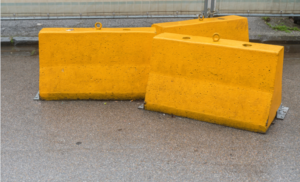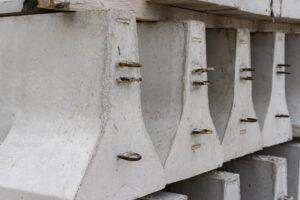Concrete Barriers. They’ve managed to have all types of names attached to them over the years from, K-Rails, highway barriers, and more. One name that has held strong for the last 77 years is Jersey Barriers. Though it’s the most used name, many wonder, why are concrete barriers called Jersey Barriers?
Early Concrete Barriers
By the 1940’s the development of highways was increasingly expanding, but as more cars were being developed there still wasn’t infrastructure in place for treacherous long stretches. There was one dangerous path known as the “Grapevine Grade”.
The Grapevine Grade had some of the most notorious curves and steep grades that were associated with several fatal head-on collisions. Having some of the highest numbers of fatal car accidents, the California Division of Highways searched ways to reduce their numbers. Thus, the early conceptions of parabolic concrete barriers were born.
Concrete barriers were developed to stop a vehicle from crossing the median of a highway. When the tire of a vehicle rolls over the lower angle towards the bottom of its structure, it redirects it using a higher angle to direct back onto the road. This avoids collisions and causes minimal damage. Once California implemented these barriers, many other states began to experiment with this idea, one being New Jersey.
New Jersey Barriers
New Jersey started experimenting with their own concrete barriers in 1955. Like California’s Grapevine Grade, New Jersey implemented its first barrier on a dangerous mountain section of US-22 at 18 inches tall. Though this first barrier was successful, changes were still needed to ensure it was effective.

Through several processes of trial and error, New Jersey increased their initial size of barriers to 20 inches. The two-inch increase still was not able to redirect a number of vehicles for long stretches of highway, so it increased to 24 inches, then settled on 32 inches with a 24 inch base by 1959.
Though California and New Jersey dimensions were set, other states were still struggling to develop their own with little data being public to pull from for conception. In addition to little data on build, there was a consecutive worry of cost.
Concrete Barrier Evolution
During the 1960’s, New Jersey officially began properly testing its barriers which was a stark difference from its earlier trial and error methods. Its’ testing consisted of conducting a series of crash test and observing results for formal data. The data from these test lead to several states’ comfortability adopting these concrete jersey barriers onto their highways. California specifically installed Jersey Barriers along a 132 mile stretch of highways.
Presently, technology is constantly evolving which has ensued changes in model vehicles, road infrastructure, and more. Jersey Barriers has continued to evolve along with the time to maintain effectiveness. Many other states have adopted 42-inch barriers to help block headlights from oncoming traffic. This size change has gone to save thousands of lives and helped ensure the safety for larger trucks where a 32-inch barrier would make little difference.
A size increase isn’t the only change in barriers that’s been developed over the last few decades. An F-shape barrier has been made with a flatter slope and lower bottom section to be more functional for modern cars. Steep rebar loops have been added to Jersey Barriers to help lifting the solid block of concrete easily.
A Modern Version of Jersey Barriers
Most recently the development of plastic alternatives to concrete has become wildly popular. Plastic Jersey Barriers follow the same guidelines for molding but use a plastic shell with a hollow interior. Depending on its stage, the Plastic Jersey Barrier can be light or heavy.
For instance, when it’s being delivered, it’s light. Once it’s set in place and filled with water, it’s firm and can pack a punch just like its’ concrete brother. In addition to portability, its clear delineation, versatility, and visibility in bright orange or white colors are more advantages to this plastic alternative.
At 48 Barriers, we provide the most functional, reasonably priced, concrete barriers your infrastructure, events, or more may need. Contact us to learn more about our concrete barriers.




